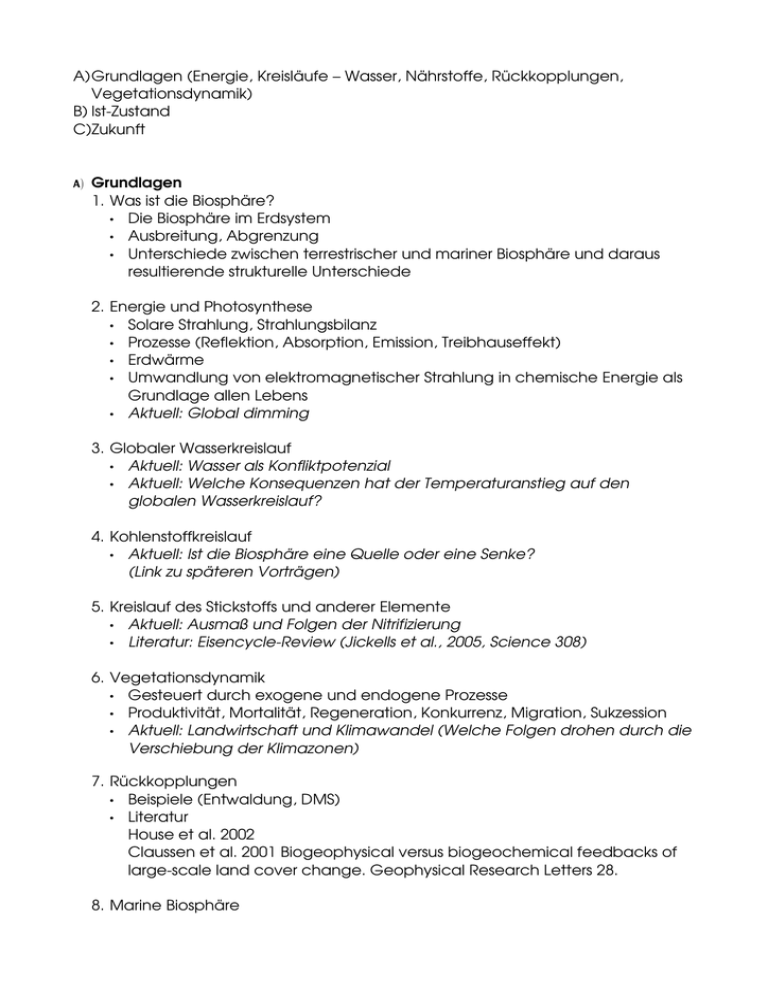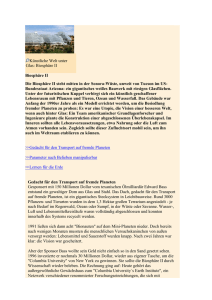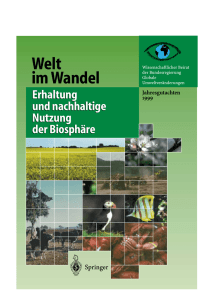Themenübersicht - Potsdam Institute for Climate Impact Research
Werbung

A)Grundlagen (Energie, Kreisläufe – Wasser, Nährstoffe, Rückkopplungen, Vegetationsdynamik) B) Ist-Zustand C)Zukunft A) Grundlagen 1. Was ist die Biosphäre? • Die Biosphäre im Erdsystem • Ausbreitung, Abgrenzung • Unterschiede zwischen terrestrischer und mariner Biosphäre und daraus resultierende strukturelle Unterschiede 2. Energie und Photosynthese • Solare Strahlung, Strahlungsbilanz • Prozesse (Reflektion, Absorption, Emission, Treibhauseffekt) • Erdwärme • Umwandlung von elektromagnetischer Strahlung in chemische Energie als Grundlage allen Lebens • Aktuell: Global dimming 3. Globaler Wasserkreislauf • Aktuell: Wasser als Konfliktpotenzial • Aktuell: Welche Konsequenzen hat der Temperaturanstieg auf den globalen Wasserkreislauf? 4. Kohlenstoffkreislauf • Aktuell: Ist die Biosphäre eine Quelle oder eine Senke? (Link zu späteren Vorträgen) 5. Kreislauf des Stickstoffs und anderer Elemente • Aktuell: Ausmaß und Folgen der Nitrifizierung • Literatur: Eisencycle-Review (Jickells et al., 2005, Science 308) 6. Vegetationsdynamik • Gesteuert durch exogene und endogene Prozesse • Produktivität, Mortalität, Regeneration, Konkurrenz, Migration, Sukzession • Aktuell: Landwirtschaft und Klimawandel (Welche Folgen drohen durch die Verschiebung der Klimazonen) 7. Rückkopplungen • Beispiele (Entwaldung, DMS) • Literatur House et al. 2002 Claussen et al. 2001 Biogeophysical versus biogeochemical feedbacks of large-scale land cover change. Geophysical Research Letters 28. 8. Marine Biosphäre • • • B) Warum so wichtig: Nahrungsquelle, Küsten sind die am dichtesten besiedelten Gebiete. Überfischung, Verschmutzung Aktuell: Die Zukunft der thermohalinen Zirkulation Ist-Zustand 9. Wie hat der Mensch die Erdoberfläche verändert und welche Folgen ergeben sich daraus? • Aktuell: Human appropriation of NPP • Literatur: Rojstaczer et al. 2001 Human appropriation of photosynthesis products. Science 294. Haberl and Lucht 2004 Defining the human appropriation of net primary production. LUCC Newsletter 10. 10.Landnutzung und Kohlenstoff • Welche Veränderungen sind mit der Landnutzungsänderung verbunden und welche Auswirkungen haben sie? • Erosion, Evapotranspiration, mikrobielle Aktivität im Boden, organische Substanz • Literatur: DeFries et al. 1999 Houghton 1983 11.Beobachtung der Biosphäre mit Fernerkundung • Grundlagen der Vegetationsfernerkundung (Reflektionsspektren, Vegetationsindizes) • Aktuell: Wird der Norden grüner? Veränderungen von Primärproduktion und Phänologie. • Literatur: Myneni et al, 1997 Lucht, 2002 12.Biodiversität • Trends, Brennpunkte, Mögliche Folgen • Aktuell: 13.Rolle der Böden in der Biosphäre • Definition, Entwicklung, Bedeutung für den Menschen • Erosion, physikalische und chemische Degradation, organische Substanz, Versalzung, Bodenverdichtung, Entwaldung, Drainage • Aktuell: C) Zukunft 14.Brennpunkte des Globalen Wandels – Die boreale und arktische Zone • Literatur: ACIC-Report 15.Brennpunkte des Globalen Wandels – Die semiariden Gebiete • Degradation, Desertifikation • Auslöser, Trends, Folgen 16.Neue Landnutzung – Das Beispiel Bioenergie • Grundlagen • Potentielle Konflikte mit Nahrungsmittelproduktion 17.Zukunft der Biosphäre im Modell • Wie entwickelt sich die „Klimaschutzfunktion“ der Biosphäre? • Unsicherheiten und woher kommen sie? • Literatur: Cramer et al. 2001 Schaphoff et al. 2005 18.Welchen Wert hat die Biosphäre? • Goods and services • Monetarisierung • Millenium Ecosystem Assessment • Ecosystem design • Literatur: Palmer et al. 2004 Ecology for a crowded planet. Science 304 Mooney et al. 2005 Confronting the human dilemma. Nature 434 19.Wege zur Nachhaltigkeit • Definition, Ziele, Strategien Literatur Bonan GB 2002 Ecological Climatology: Concepts and Applications. Cambridge University Press (ISBN 0-42-180476-0) Charlson, R. J., J. E. Lovelock, M. O. Andreae & S. G. Warren, 1987. Oceanic phyto plankton, atmospheric sulphur, cloud albedo and climate. Nature 326: 655–661. Claussen et al. 2001 Biogeophysical versus biogeochemical feedbacks of largescale land cover change. Geophysical Research Letters 28. Cramer et al. 2001 Global response of terrestrial ecosystem structure and function to CO2 and climate change: results from six dynamic global vegetation models. Global Change Biology 7. DeFries RS, Field CB, Fung I, Collatz GJ, Bounoua L 1999 Combining satellite data and biogeochemical models to estimate global effects of human-land cover change on carbon emissions and primary productivity. Global Biogeochemical Cycles 13. Haberl and Lucht 2004 Defining the human appropriation of net primary production. LUCC Newsletter 10. Hassol 2005 Impacts of a warming climate – Arctic climate impact assessment. Cambridge University Press. Downloadbar: http://amap.no/acia/ Houghton RA 2003 Revised estimates of the annual net flux of carbon to the atmosphere from changes in land use and land management 1850-2000. Tellus 55B. Kates et al. 2002 Sustainability science. Science 292. Rojstaczer et al. 2001 Human appropriation of photosynthesis products. Science 294. Sala et al. 2000 Global biodiversity scenarios for the year 2100. Science 287. Schaphoff et al. 2005 Terrestrial biosphere carbon storage under alternative climate scenarios. under revision. Vitousek et al. 1997 Human alteration of the global nitrogen cycle: causes and consequences. Issues in Ecology 1. Vitousek et al. 1997 Human domination of Earth's ecosystems. Science 277. Weart 2004 Biosphere: How life alters climate. From the website: The discovery of global warming. Downloadbar: www.aip.org/history/climate/pdf.htm Western et al. 2001 Human-modified ecosystems and future evolution. PNAS 98. Tips zur Literaturrecherche • scholar.google.com

